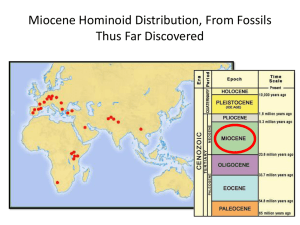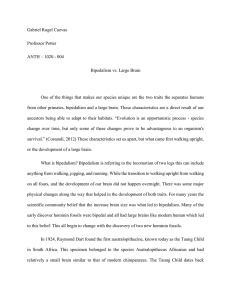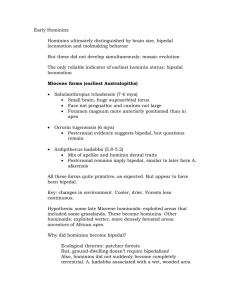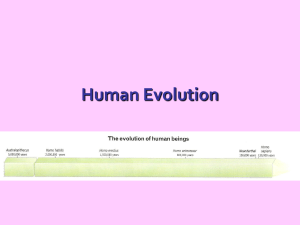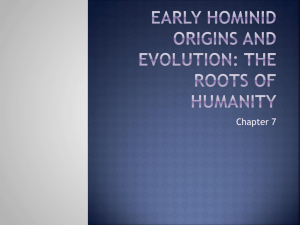Hominins (us) are Hominoids
advertisement
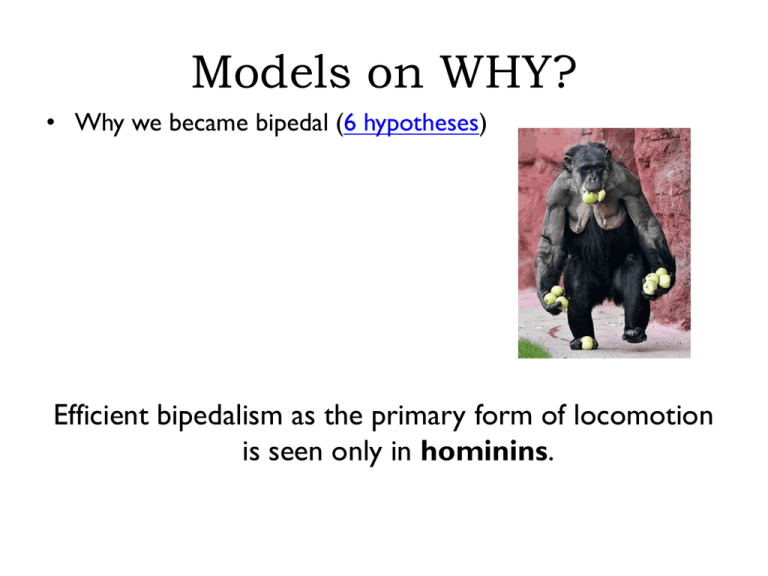
Models on WHY? • Why we became bipedal (6 hypotheses) Efficient bipedalism as the primary form of locomotion is seen only in hominins. BECOMING HUMAN PART 1 • NOVA Becoming Human review… • Lucy and bipedalism – Habitual vs. Obligate Bipedalism – Ossa Coxae – Foot as stable support – Longer legs – Full knee extension Hominins (us) are Hominoids Hominins (us) review… • Defined by dental features, bipedal locomotion, large brain size, and tool making behavior • Characteristics that developed at different rates, called mosaic evolution Biocultural Evolution: The Human Capacity for Culture • All aspects of human adaptation, including technology, traditions, language, religion, marriage patterns, and social roles. • Culture is a set of learned behaviors; it is transmitted from one generation to the next through learning and not by biological or genetic means. • Material culture is part of the cultural complex… Oldowan Tool Industry • The Oldowan is the first known industrial complex in prehistory. It takes its name from Olduvai Gorge, Tanzania • Oldowan tool use is estimated to have begun about 2.5 million years ago (mya), lasting to as late as 0.5 mya. • It is thought that Oldowan tools were produced by several species of hominids ranging from late Australopithecus to early Homo. Chopping tool Biface tool Dating (relative) • Relative dating methods. These tell you that something is older or younger than something else – Stratigraphy- based on the law of superposition, which states that a lower layer is older than a higher one – Flourine analysis, used to date remains of bone – Biostratigraphy – paleomagnetism Dating (absolute) • Absoulte dating methods – Chronometric (Absolute) dating methods are based on calendar years – K/Ar, or potassium argon method used to date materials in the 5-1 mya range – Carbon-14 method used to date organic material extending back to 75,000 years – Thermoluminescence – Uranium series dating – Electron spin resonance (ESR) The “Study of Old Humans” PALEOANTHROPOLOGY How far back? 7 – 8 million years 70% of our history resides in Africa Extensive changes in the last 10 years 1992 3-4 million 1998 4.4 2000 6 2003 7 million Early Hominoid – Where to Look? Rift Valley of East Africa Southern Africa 3 Major Groups Pre-australopiths (7-4.4mya) Australopiths (4.2- 1 mya) Early Homo (2.4 – 1.4) Lucy 3.7 –3.5 mya Don Johanson Dicovered in Hadar in 1974 Lucy in combination w/ Leakey footprints tell us about locomotion and stature Lucy 40% of skeleton, one of three most complete, Pre-100,000 Accurate Dates due to Volcanic Ash layers Laetoli (Ash Footprints) Discovered in 1978 Laetoli (Ash Footprints) 1. Convergent Big Toe 2. Clearly Bipedal 3. Arch 4. Slow Moving “Strol” 5. Short Stride
